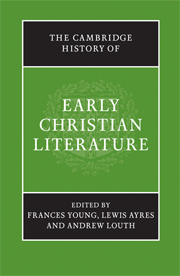Book contents
- Frontmatter
- PART ONE The Beginnings: The New Testament to Irenaeus
- PART TWO THE THIRD CENTURY
- A LITERARY GUIDE
- 11 The Alexandrians
- 12 The beginnings of Latin Christian literature
- 13 Hippolytus, Ps.-Hippolytus and the early canons
- 14 Cyprian and Novatian
- 15 The earliest Syriac literature
- 16 Concluding review: the literary culture of the third century
- B CONTEXT AND INTERPRETATION
- PART THREE FOUNDATION OF A NEW CULTURE: FROM DIOCLETIAN TO CYRIL
- Bibliographies
- Index
- Map: The Roman Empire in the late fourth century AD"
- References
13 - Hippolytus, Ps.-Hippolytus and the early canons
from A - LITERARY GUIDE
Published online by Cambridge University Press: 28 March 2008
- Frontmatter
- PART ONE The Beginnings: The New Testament to Irenaeus
- PART TWO THE THIRD CENTURY
- A LITERARY GUIDE
- 11 The Alexandrians
- 12 The beginnings of Latin Christian literature
- 13 Hippolytus, Ps.-Hippolytus and the early canons
- 14 Cyprian and Novatian
- 15 The earliest Syriac literature
- 16 Concluding review: the literary culture of the third century
- B CONTEXT AND INTERPRETATION
- PART THREE FOUNDATION OF A NEW CULTURE: FROM DIOCLETIAN TO CYRIL
- Bibliographies
- Index
- Map: The Roman Empire in the late fourth century AD"
- References
Summary
Hippolytus is one of the most enigmatic figures in the history of the early Church. He appears to have been a man of great importance, but both his identity and his writings are surrounded with problems. The traditional depiction of his life, since the discovery and publication in 1851 of the Refutation of All Heresies, places his activities in Rome in the first third of the third century. He was a priest there perhaps as early as the bishopric of Victor (189–99). He strongly opposed the endorsement of modalistic monarchianism by the bishops Zephyrinus (199–217) and Callistus (218–22), and what he considered to be the lax penitential policy of the latter, and consequently he became bishop of a schismatic church in Rome in opposition to Callistus. He was the author of a large number of exegetical works, two works against heresies, a work concerning the universe, a chronicle, a computation of the dates of Easter, and a work on church order. In 235 he was exiled to Sardinia, along with Pontianus, bishop of Rome, by the Emperor Maximinus Thrax. Both men died there as martyrs. Before suffering martyrdom, however, it is assumed that Hippolytus was reconciled with Pontianus, for Fabian, bishop of Rome (236–50), brought both back to Rome for burial, and Hippolytus was later recognized as a martyr by Damasus (bishop 366–84). Some, however, relying on a reference in the Chronicon Paschale to Hippolytus, bishop of Porto near Rome, take the latter to have been the author and martyr, and not the priest who became head of a schismatic church in Rome.
- Type
- Chapter
- Information
- The Cambridge History of Early Christian Literature , pp. 142 - 151Publisher: Cambridge University PressPrint publication year: 2004
References
- 1
- Cited by



